Implication of in situ Sr Isotope of Scheelite for Tungsten Mineralization: A Case Study of the Nanyangtian Scheelite Deposit, Southeast Yunnan, China
-
摘要: 南秧田钨矿床位于滇东南老君山W-Sn矿集区,地处扬子地块和印支地块的结合部位,地质背景复杂并遭受了多期岩浆活动和区域变质事件,其成矿时代和成因一直存在争议。本文对矽卡岩型和长石-石英脉型白钨矿开展了年代学、原位微量元素、Sr同位素研究,分析了两类白钨矿年龄、成因以及物质来源的差异。结果表明,长石-石英脉内与白钨矿共生辉钼矿的Re-Os同位素等时线年龄为151.0±1.3Ma,明显晚于矽卡岩矿体年龄,属于后期成矿事件。矽卡岩型白钨矿的轻稀土富集、重稀土强烈亏损,Eu呈明显负异常(δEu=0.46),∑REE平均含量为65.60μg/g,Mo平均含量为240.16μg/g,Sr平均含量为883.43μg/g;长石-石英脉型白钨矿稀土呈Eu正异常(δEu=2.8)的平坦型,∑REE平均含量为194.40μg/g,Mo平均含量为16.01μg/g,Sr平均含量为129.26μg/g。以上两者微量、稀土元素含量的差别显示它们具有性质明显不同的流体来源,Eu异常指示矽卡岩型白钨矿形成于氧逸度较高的环境,长石-石英脉型白钨矿形成于还原性环境。矽卡岩白钨矿87Sr/86Sr值相对较低,并且比较均一,介于0.71319~0.71491之间,表明成矿流体主要来自岩浆热液;长石-石英脉型白钨矿87Sr/86Sr值较高且变化范围大,介于0.71537~0.72803之间,平均0.72079,呈现出变质流体特征。两种不同类型白钨矿Sr同位素都具有二元混合的特征,显示长石-石英脉型白钨矿对矽卡岩型白钨矿有叠加改造作用,成矿流体与围岩的强烈交代作用是白钨矿形成的关键。要点
(1) 南秧田长石-石英矿脉型矿体形成时间为151.0±1.3Ma,为晚期又一次成矿事件。
(2) 应用原位微量元素、原位Sr同位素技术区分出两类白钨矿属于不同成矿流体来源和不同成因。
(3) 早期矽卡岩型白钨矿为岩浆热液成因,成矿流体以岩浆热液为主。晚期长石-石英脉型白钨矿为变质热液成因,成矿流体以变质热液为主。
HIGHLIGHTS(1) The ore body of feldspar-quartz vein scheelite in Nanyangtian formed at 151.0±1.3Ma.
(2) in situ trace element and in situ Sr isotopes of scheelite led to the identification of two types of scheelite with different fluid sources and genesis.
(3) The formation of early skarn scheelite was related to magmatic-hydrothermal fluids, whereas metaphorical-hydrothermal fluids were responsible for the formation of later feldspar-quartz mineral veins.
Abstract:BACKGROUNDThe Nanyangtian scheelite deposit is an important skarn scheelite deposit in Yunnan Province, which is located in Laojunshan W-Sn deposit area, Southeast Yunnan. Due to its complex geological background and multi-stage metallogenic characteristics, its mineralization age and genesis remain controversial.OBJECTIVESTo explore the metallogenic age, genesis and material origins of two types of scheelite deposits in order to explore formation patterns.METHODSMolybdenum Re-Os isotope dating was used to constrain the age, whereas in situ trace element and in situ Sr isotopes of scheelite were used to determine the composition of trace elements and Sr isotopes in scheelite.RESULTSThe Re-Os isochron age of molybdenite associated with scheelite in the feldspar-quartz mineral vein of Nanyantian was 151.0±1.3Ma, younger than the age of skarn mineralization, indicating a later mineralization event. The skarn-type scheelite was enriched in light rare earth elements with negative Eu anomaly (δEu=0.46). The average content of ∑REE, Mo and Sr in skarn scheelite were 65.60, 240.16 and 883.43μg/g, respectively. Feldspar-quartz vein-type scheelite showed a flat rare earth pattern with positive Eu anomaly (δEu=2.8) and average content of ∑REE, Mo and Sr were 194.40, 16.01 and 129.26μg/g, respectively. respectively. The skarn scheelite had a relatively low and uniform 87Sr/86Sr value of 0.71319 to 0.71491, indicating that the ore-forming fluids were mainly magmatic-hydrothermal in origin, whereas feldspar-quartz vein type scheelite had a wide 87Sr/86Sr range of 0.71537 to 0.72803, with an average of 0.72079, characteristic of metamorphic fluids.CONCLUSIONSThe differences in trace and rare earth element contents between two types of mineralization indicate that they have different fluid sources. The negative Eu anomaly of the skarn-type scheelite indicates a high oxygen fugacity environment, whereas the feldspar-quartz vein-type scheelite is formed in a reductive environment in terms of positive Eu anomaly. Sr isotopes of two different types of scheelite display a feature of binary mixing, indicating that feldspar-quartz vein-type scheelite has a superimposed transformation effect on skarn-type scheelite, and the strong metasomatism of ore-forming fluids and surrounding rocks is the key to the formation of scheelite.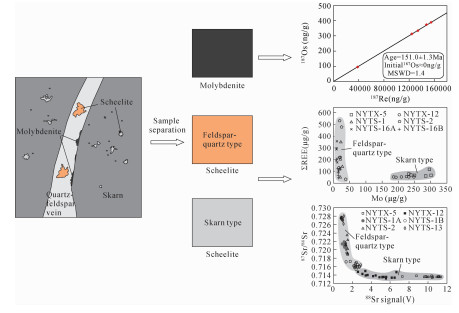
-
Keywords:
- scheelite /
- in situ Sr isotope /
- mineralization epoch /
- source of ore-forming fluid /
- Nanyangtian
-
多环芳烃(PAHs)是一种自然界中广泛分布的半挥发性有机污染物,该类化合物由两个及以上的苯环结构组成,其主要来源是化石燃料的不完全燃烧[1]。该类污染物对动物体具有较大的致癌、致畸、致突变的危害,其中致癌性最大的是4~6环的稠环PAHs[2]。该类化合物在环境中分布广泛,但由于环境基体复杂且其含量较低,很难直接、快速地对样品中PAHs进行分析[3-4],常常需要结合样品前处理技术进行富集。常规的样品前处理方法,如索氏提取、加速溶剂提取、液液萃取等方式耗时长,且使用大量有机溶剂,容易对环境造成二次污染,因此有必要建立一种样品前处理过程高效绿色、分析检测快速灵敏的新方法。
固相微萃取(SPME)是一种集分离、富集、进样于一体的样品前处理技术[5-6],在操作过程中避免了大量有机试剂的使用,在保证绿色环保的基础上具有提高目标物富集效率[7-10]的优点。已有很多研究者将SPME技术应用于PAHs的检测中并取得了较好的萃取效果[4, 11]。对于SPME技术而言,涂层的性能是制约萃取效率和目标分析物种类的关键因素[12-14],是目前SPME技术研究的热点问题。金属有机骨架化合物(MOFs)是一类独特的多孔材料[15-16],其永久性纳米孔隙率、高比表面积、均匀且可调节的孔径、易于功能化和表面改性[17]的特点,使MOFs材料在分离、气体储存、分子传感、富集和催化等方面具有广阔的应用前景[18-22]。然而,包括MOF-5和HKUST-1在内的MOFs材料在水溶液中稳定性较差,一定程度上了限制了它的实际应用。研究得到MIL-53(M=Al,Cr,Fe)是一种常见的金属骨架有机化合物,其中心金属离子可以是三价铁、铝或铬离子,配体为对苯二甲酸,是一类合成简便、性能优良、化学稳定性较好的MOFs材料,且在吸附水时其孔隙率没有明显变化[23]。Chen等[24]采用中性硅酮胶黏接法制备了MIL-53(Al,Cr,Fe)SPME涂层纤维,进行了浸入式萃取研究,并结合GC-MS/MS检测,结果显示三种MIL-53(M)涂层对PAHs都具有较好的萃取效率。该研究结果表明,该类水稳定性MOFs材料的SPME涂层对水样中芳香族化合物的富集和检测具有很好的应用前景,特别是对于浸入式萃取模式下萃取环境水样中难挥发的PAHs类物质具有较大的优势。传统的MOFs涂层制作方式,如水热原位沉积法、溶胶-凝胶法(sol-gel)、黏合固定法等往往存在步骤复杂、涂层机械强度较差等不足[21, 25-26]。
本研究在MOFs材料优良的吸附性能以及较好的水稳定性的基础上,采用金属基质材料原位自转化的方式[27],在铁丝基质上直接生长MOFs涂层,该过程使得金属丝不仅作为支撑吸附剂的基质材料,而且还作为铁源参与MOFs材料的形成,不需要再添加金属盐,一定程度上节约了成本,避免重金属离子对环境的二次污染。将该涂层应用于环境水体中PAHs的萃取,并结合GC-MS进行检测,建立了环境水样中7种PAHs的SPME检测方法,以期为高效SPME涂层的简单、快速制备提供新思路。
1. 实验部分
1.1 材料和主要试剂
铁丝(直径为0.2mm,纯度99.9%,赛维精密金属材料有限公司)。
苯并(a)蒽(BaA,99.8%);䓛(CHR,99.8%);苯并(b)荧蒽(BbF,99.7%);苯并(k)荧蒽(BKF,100%);苯并(a)芘(BaP,99.8%);茚苯(1, 2, 3-cd)芘(IPY,98.8%);二苯并(a, n)蒽(DBA,98.3%);苯并(ghi)芘(二萘嵌苯)(BPE,98.4%,美国AccuStandard公司);100μm PDMS聚二甲基硅氧烷涂层(美国Supelco公司)。
对苯二甲酸(H2BDC,98%)、六水氯化铁(FeCl3·6H2O,麦克林生化科技有限公司);三乙胺(TEA,国药集团);超纯水;N, N-二甲基甲酰胺(DMF,国药集团);乙醇(国药集团)。丙酮(美国Tedia公司);甲醇(美国Tedia公司)。
上述试剂除丙酮和甲醇为色谱纯,其余试剂为分析纯。
1.2 仪器及工作条件
气相色谱-质谱仪(GCMS-QP2010plus,日本岛津公司)。该仪器测试PAHs条件:载气为高纯氦(99.999%);色谱柱为Rtx-1MS(30m×0.25mm×0.25μm);流量1.2mL/min,不分流进样;进样口260℃;离子源温度250℃;接口温度260℃;升温程序:初始温度50℃,保持2min,以20℃/min升至230℃,再以2.5℃/min升至250℃,保持2min。检测方式特征离子扫描(SIM)。
X射线粉晶衍射仪(D8-FOCUS,德国布鲁克科技有限公司);傅里叶变换红外光谱仪(Nicolet 6700,美国ThermoFisher公司);高分辨率场发射扫描电子显微镜(SU8010,日本日立公司);全自动进样装置(MPS,德国Gerstel科技有限公司)。
1.3 实验方法
1.3.1 固相微萃取涂层IW@MIL-53(Fe)的制作
将直径为0.2mm的铁丝截为3cm的一段,置于10mol/L盐酸中反应15min,待反应至合适尺寸后取出铁丝,随后将其依次置于丙酮、甲醇、超纯水的条件下超声处理30min,取出铁丝于65℃烘箱中干燥12h备用。取0.65g对苯二甲酸溶于50mL N, N-二甲基甲酰胺中,加入5mL三乙胺,室温下搅拌15min;将反应液置于100mL高压反应釜中,将处理好的铁丝放入反应液中,并将密封好的高压反应釜置于180℃的条件下反应12h。将制作好的涂层置于100℃的真空烘箱中12h。将自制涂层在GC进样口280℃老化2h用以去除多余的溶剂。
1.3.2 金属有机骨架化合物多孔膜MIL-53(Fe)水热合成
将810mg六水氯化铁和498mg对苯二甲酸溶于15mL N, N-二甲基甲酰胺中,常温搅拌10min,置于50mL反应釜中150℃保持6h,带溶液冷却至室温后,超纯水清洗,转移至600mL超纯水中分散24h后,过滤,60℃烘干24h[23, 28-29]。
1.3.3 浸入式SPME过程
将制好的样品溶液转移到MPS自动进样平台特定区域,由自动进样器控制自制涂层装置在设定的萃取温度、萃取时间的条件下完成对PAHs的萃取,接着萃取了目标物的涂层被转移到GC-MS的进样口进行解吸分析。
1.3.4 实际样品采集和制备
样品一采自东湖(武汉);样品二采自长江(武汉)。采集时间均为同一天的上午8:00~10:00。将采集的环境水样放置在25℃的室温下静置1h后经0.45μm微孔滤膜过滤,将处理好的水样取10mL于20mL顶空瓶中并放置在4℃的条件下备用。
2. 结果与讨论
2.1 自制IW@MIL-53(Fe)涂层表征
自制IW@MIL涂层通过扫描电子显微镜进行表征(图 1)。图 1a为经盐酸蚀刻的铁丝,可以看出经盐酸处理后铁丝表面呈“鳞片状”,该表面形状与光滑的铁丝表面相比,可以增大铁丝表面与反应液的接触面积;图 1b为经过水热反应后铁丝表面的变化,一层均匀的“树皮褶皱”材料覆盖在铁丝表面,铁丝反应前后直径无明显变化,由161μm变为163μm,局部放大(图 1c)可以看出该层状物质是由小的片状颗粒堆积而成;图 1d为该涂层的截面图,从该图中可以得出涂层平均厚度为10μm;为保护涂层外侧的吸附材料,避免在浸入式萃取过程中脱落和污染,涂层外涂覆了一层薄薄的中性硅酮胶加以固定,如图 1e、1f所示,通过与图 1b的对比,可以看出中性硅酮胶将吸附材料紧紧地包覆在胶层内部,其厚度约为15μm。
从X射线衍射图谱(图 2a)可以看出,水热合成的MIL-53(Fe)与原位转化的材料在衍射峰的位置上对应良好,可以证明为同一种物质,表明铁丝上已原位转化出一层MIL-53(Fe)的薄膜。通过红外光谱图(图 2b)可以看出,红外光谱的所有振动带与水热合成的MIL-53(Fe)的数据吻合良好。红外光谱在近1645cm-1处表现出羧基的强烈伸缩振动,证明了对苯二甲酸中的—COOH基团与Fe金属离子成功结合。
2.2 自制IW@MIL-53(Fe)涂层萃取条件的优化
2.2.1 萃取温度
SPME在萃取的过程温度可以促进待测物在基质中的扩散以及扩大待测物的分配系数,加快与涂层之间的分配平衡,从而缩短达到平衡所需的时间。但随着温度的升高,涂层本身萃取相的分配系数也会下降,导致涂层灵敏度的降低[30-32]。为获取最佳的萃取温度以发挥SPME涂层最佳的萃取性能,实验中在萃取时间为50min,解吸温度为280℃,解吸时间为4min的条件下对萃取温度进行优化。图 3a结果表明,随着温度的升高,涂层的萃取性能也随之增强,直到80℃达到最佳性能,随之性能略有下降。因此该自制涂层的最佳萃取温度为80℃。
2.2.2 萃取时间
由于SPME技术是建立在平衡吸附基础上的样品前处理技术,需要使待测组分与萃取相达到平衡状态时,才能够保证测试数据的准确性和萃取过程的重现性。为保证在最短的时间内完成有效的萃取过程,实验设置了自制涂层在萃取温度为80℃,解吸温度为280℃,解吸时间为4min的条件下分别萃取5、10、20、25、30、40、50、60min。图 3b结果表明,随着时间的增加,自制涂层在萃取50min后逐渐达到萃取平衡。因此选取的最佳萃取时间为50min。
2.2.3 解吸时间
为确定一个最佳的解吸时间,实验在萃取温度为80℃,萃取时间为50min,解吸温度为280℃的条件下设置了1、2、3、4、5min五个解吸时间。图 3c结果表明,解吸4min后,涂层上的目标分析物已经解吸完全。因此该自制涂层的最佳解吸时间为4min。
2.2.4 解吸温度
SPME进样的解吸温度需要稍高于直接进样的温度,温度越高,涂层上的物质解吸得越完全,但这也存在着目标分析物分解以及高温降低涂层使用寿命的问题,因此解吸时不宜使用过高的温度。为确定一个合适的解吸温度,实验在萃取温度为80℃,萃取时间为50min,解吸时间为4min的条件下设置了240℃、250℃、260℃、270℃、280℃、290℃六个解吸温度进行测试。图 3d结果表明,解吸温度在280℃的条件下,测试性能最佳。因此该自制涂层的最佳解吸温度为280℃。
2.2.5 离子强度
无机盐的加入一方面可以改变样品溶液中的相界面性质,进而影响组分之间的分配系数;另一方面,加入无机盐之后样品溶液的离子强度增强,产生盐析效应,降低了目标分析物在溶液中的溶解度,有利于涂层的萃取。为了确定加入无机盐的用量,实验设计了萃取温度为80℃,萃取时间为50min,解吸温度为280℃,解吸时间为4min,以饱和食盐水为盐溶液的最大浓度,将其稀释为0%、15%、30%、50%、65%、80%、100%的氯化钠溶液。图 4结果表明,在氯化钠浓度为50%的条件下萃取效率达到最佳。因此该自制涂层的最佳盐浓度为50%的饱和氯化钠溶液。
2.3 自制IW@MIL-53(Fe)涂层性能评价
为了考察自制涂层的萃取性能,实验选取性能稳定的商用PDMS涂层为参照,以7种多环芳烃为目标分析物,在最优萃取条件下与商用100μm PDMS涂层萃取多环芳烃的性能进行了比较,对比结果如图 5a所示。实验结果表明,自制涂层的萃取性能略优于商用涂层1~2倍,表现出良好的萃取性能。同时比较了外涂的硅酮胶的吸附能力,得到IW@MIL-53(Fe)涂层的吸附性能主要是来自MIL-53(Fe)材料。
为了测试涂层的使用次数,实验比较了涂层使用1次、60次、90次、120次萃取目标分析物的萃取性能,对比结果如图 5b所示。从图中可以看出,该涂层在使用120次之后萃取性能并没有明显下降,因此,该自制涂层具有较长的使用寿命,使用次数大于120次,显著优越于商用涂层的有效使用次数(< 80次)[33]。自制涂层良好的稳定性,是由于MIL-53(Fe)本身具有良好的水稳定性,此外外涂的硅酮胶也起到了很好的保护作用,避免了外层涂层材料的脱落,提高了涂层的重复使用次数。
在最佳的实验条件下,考察了IW@MIL-53(Fe)涂层结合GC-MS测定7种多环芳烃的分析性能(表 1),得到该方法的检出限(LOD)为0.03~2.25ng/L,定量限(LOQ)为0.10~7.50ng/L,线性范围为250~10000ng/L,相关系数为0.9903~0.9991;同一根涂层测定结果的相对标准偏差(RSD,n=5)为3.1%~10.4%;不同根涂层测定结果的相对标准偏差(RSD,n=3)为3.0%~9.5%。
表 1 IW@MIL-53(Fe)涂层SPME-GC-MS分析7种PAHs的分析性能Table 1. Analysis performance of 7 kinds of PAHs by IW@MIL-53(Fe) coating with SPME-GC-MS分析物 线性范围(ng/L) R2 LOD (ng/L, S/N=3) LOQ (ng/L, S/N=10) RSD(%) 涂层内(n=5) 涂层间(n=3) BaA 250~10000 0.9991 0.03 0.10 3.1 6.7 CHR 250~10000 0.9922 0.13 0.43 6.2 3.0 BbF 250~10000 0.9922 0.11 0.37 8.9 5.7 BKF 250~10000 0.9903 0.26 0.87 5.2 5.5 BaP 250~10000 0.9933 0.36 1.20 7.7 6.0 IPY 250~10000 0.9962 1.50 5.00 10.4 9.5 BPE 250~10000 0.9982 2.25 7.50 10.4 2.5 2.4 实际样品分析
按照1.3节的实验方法,采用自制IW@MIL-53(Fe)涂层结合GC-MS分析方法对东湖和长江的实际水样进行分析,目标分析物浓度低于检出限,结果未检出。对样品进行加标回收实验,得到该方法的回收率为80.1%~108.5%(表 2)。
表 2 实际水样中PAHs分析结果Table 2. Analytical results of PAHs in actual water samples分析物 东湖水样 长江水样 浓度(ng/L) 加标浓度(ng/L) RSD (%, n=3) 回收率(%) 浓度(ng/L) 加标浓度(ng/L) RSD (%, n=3) 回收率(%) BaA ND 500 11.6 89.3 ND 500 3.5 80.1 CHR ND 500 8.0 102.3 ND 500 7.0 92.5 BbF ND 500 8.8 96.5 ND 500 10.6 84.6 BKF ND 500 5.5 91.1 ND 500 6.4 89.5 BaP ND 500 11.1 90.6 ND 500 9.6 83.0 IPY ND 500 8.6 91.8 ND 500 5.1 108.5 BPE ND 500 4.9 99.7 ND 500 14.4 91.8 注:ND表示未检出。 3. 结论
为了提高固相微萃取涂层的萃取效率和机械强度,本文通过原位自转化的方式在铁丝上生长出一层MIL-53(Fe)的MOFs膜,该方法在转化过程中,铁丝既作为涂层纤维的基质又可以为MIL-53(Fe)的生成提供铁离子,不需要向反应体系中额外添加金属盐。研究结果表明:采用金属基质原位自转化的方式制备固相微萃取涂层,具有涂层制备快速简便、环境友好、性质稳定等优点。
将该新材料用作固相微萃取涂层,以7种PAHs作为目标分析物,以浸入式萃取的模式并结合GC-MS作为检测手段验证了其萃取性能,应用于长江及东湖水样中PAHs的测定,得到加标回收率为80.1%~108.5%。建立的SPME-GC-MS方法实现了有机污染物的快速、灵敏检测,显示出良好的应用前景。
致谢: 云南文山麻栗坡紫金钨业集团有限公司对本文野外地质工作的大力支持和帮助,以及两位审稿人对本文提出的建设性意见,在此表示衷心感谢! -
表 1 长石-石英脉中辉钼矿Re-Os同位素分析结果
Table 1 Re-Os isotope analytical results of molybdate in feldspar-quartz veins
样品编号 样品质量
(g)Re(μg/g) 普Os(ng/g) 187Re(μg/g) 187Os(ng/g) 模式年龄(Ma) 测定值 2σ 测定值 2σ 测定值 2σ 测定值 2σ 测定值 2σ NYTS-16-1 0.00304 60.93 0.460 0.0309 0.0024 38.29 0.289 95.71 0.59 149.8 2.1 NYTS-16-2 0.02081 197.6 1.723 0.5608 0.0454 124.2 3.768 313.7 2.1 151.4 2.3 NYTS-16-3 0.01190 235.0 2.141 0.5961 0.0178 147.7 1.346 373.6 2.3 151.7 2.2 NYTS-16-4 0.00309 213.1 1.678 0.1013 0.0077 133.9 1.055 333.9 2.0 149.4 2.1 NYTS-16-5 0.00313 246.2 2.146 0.1744 0.0076 154.8 1.349 390.0 2.8 151.1 2.3 表 2 白钨矿中稀土元素含量测定结果
Table 2 Anaytical results of rare earth elements in scheelite
白钨矿类型 样品编号 元素含量(μg/g) δEu Mo Sr Y La Ce Pr Nd Sm Eu Gd Tb Dy Ho Er Tm Yb Lu ∑REE 矽卡岩型 NYTX-5-01 300.1 1202 0.15 8.21 28.80 5.73 24.13 1.18 0.07 0.73 0.03 0.05 0.01 0.03 < LOD < LOD 0.01 68.98 0.24 NYTX-5-02 295.2 1332 0.24 18.60 52.48 8.57 36.18 2.20 0.15 0.85 0.04 0.07 < LOD < LOD 0.01 0.04 < LOD 119.18 0.36 NYTX-5-03 283.7 1197 0.02 6.54 25.21 4.97 22.30 1.56 0.15 0.45 0.06 < LOD < LOD 0.06 < LOD 0.01 < LOD 61.30 0.60 NYTX-5-04 237.8 1167 0.34 5.71 24.43 5.11 30.62 2.65 0.21 1.33 0.10 0.47 0.03 0.04 < LOD 0.01 < LOD 70.72 0.38 NYTX-5-05 248.8 1167 0.52 8.33 28.80 4.95 23.28 1.73 0.12 0.68 0.03 0.15 0.03 0.09 < LOD < LOD < LOD 68.20 0.37 NYTX-5-06 231.6 1191 1.20 7.33 27.39 5.61 32.38 3.49 0.25 1.90 0.18 0.48 0.10 0.23 0.00 0.07 < LOD 79.41 0.33 NYTX-12-01 246.3 672.1 4.23 4.25 15.53 2.96 18.02 4.17 0.77 3.73 0.38 1.96 0.29 0.62 0.04 0.20 0.02 52.95 0.66 NYTX-12-02 231.3 607.0 3.24 3.96 15.51 3.32 20.00 4.21 0.48 3.07 0.29 1.73 0.17 0.40 0.06 0.07 0.03 53.30 0.45 NYTX-12-03 223.5 588.1 4.43 4.66 17.57 3.47 19.00 4.24 0.68 3.80 0.37 1.67 0.29 0.52 0.04 0.20 0.04 56.55 0.58 NYTX-12-04 191.8 547.5 4.72 4.70 17.99 3.00 15.74 3.04 0.48 2.41 0.18 1.11 0.24 0.46 0.06 0.47 0.03 49.91 0.60 NYTX-12-05 207.9 520.8 4.87 3.25 14.63 3.31 17.82 4.71 0.65 4.42 0.47 2.36 0.37 0.84 0.07 0.11 0.02 53.05 0.49 NYTX-12-06 183.8 407.1 4.57 2.68 14.17 3.34 19.77 5.25 0.55 3.82 0.42 2.26 0.37 0.73 0.06 0.16 0.02 53.60 0.42 长石-石英脉型 NYTS-1-01 19.0 136.0 174.20 7.83 30.75 6.59 41.23 15.67 6.61 16.33 3.50 26.85 5.92 19.34 2.64 15.93 2.16 201.35 1.41 NYTS-1-02 19.4 106.4 52.82 3.31 8.45 1.54 8.32 3.58 1.59 4.26 1.16 6.40 1.96 5.89 0.77 4.71 0.94 52.87 1.39 NYTS-1-03 17.8 150.4 91.45 4.75 23.19 5.68 29.20 8.41 7.19 8.28 1.42 10.27 2.66 7.95 1.38 8.33 1.29 119.98 2.94 NYTS-1-04 21.5 149.9 299.92 41.05 86.35 12.79 62.13 15.88 9.40 17.89 3.64 28.31 7.14 22.83 4.72 34.81 4.72 351.65 1.90 NYTS-1-05 25.4 147.4 115.65 5.13 29.22 6.12 34.18 9.97 9.09 10.18 1.79 12.52 3.31 8.66 1.66 10.33 1.42 143.58 3.08 NYTS-1-06 18.5 156.0 78.63 6.28 29.29 6.54 34.74 8.53 8.80 8.56 1.43 8.57 2.19 6.05 0.91 4.96 0.86 127.71 3.51 NYTS-2-01 17.1 165.3 120.68 16.43 39.71 7.26 42.71 13.38 11.60 16.78 3.98 28.50 6.19 18.28 2.33 11.63 1.44 220.20 2.64 NYTS-2-02 15.8 181.8 82.32 5.44 26.48 5.87 30.35 8.32 8.43 7.77 1.62 12.49 3.11 10.01 1.50 9.37 1.31 132.06 3.58 NYTS-2-03 18.2 138.9 195.53 11.58 36.86 8.00 42.80 10.24 11.37 10.68 2.56 18.15 4.43 17.55 3.84 35.18 5.12 218.36 3.71 NYTS-2-04 17.4 139.1 331.40 50.60 232.17 16.05 63.10 14.95 12.72 14.35 2.84 23.03 6.50 26.72 5.35 54.33 7.82 530.55 2.96 NYTS-2-05 24.2 229.1 379.33 59.31 137.24 19.31 72.11 15.77 9.86 17.64 3.78 33.46 8.80 35.80 6.48 50.59 6.27 476.44 2.02 NYTS-2-06 36.6 233.8 30.11 0.57 2.57 0.71 4.22 3.23 0.83 4.28 0.98 6.18 1.51 4.45 0.62 3.56 0.46 34.16 0.77 NYTS-16-A01 7.2 80.9 104.49 15.83 64.67 9.43 44.49 9.55 8.90 10.71 1.74 12.00 2.89 8.07 0.89 4.63 0.71 194.51 3.00 NYTS-16-A02 9.9 78.8 84.31 24.08 49.34 8.61 40.72 9.13 10.06 8.91 1.57 10.65 2.45 6.68 0.75 3.72 0.54 177.21 3.80 NYTS-16-A03 8.0 75.5 216.48 17.77 78.41 11.97 60.53 17.28 10.48 20.42 3.80 27.34 6.30 17.84 2.13 11.33 1.80 287.41 1.90 NYTS-16-A04 8.5 74.2 117.84 20.31 100.61 18.61 78.68 15.98 10.67 14.52 2.58 16.47 3.58 9.60 1.11 5.74 0.71 299.17 2.39 NYTS-16-A05 9.1 69.0 93.65 22.56 68.14 10.58 46.13 15.18 10.49 9.47 1.57 10.35 2.69 6.78 0.87 3.83 0.62 209.26 2.99 NYTS-16-A06 9.3 69.1 164.20 58.80 122.66 17.72 73.98 14.31 13.80 13.55 2.26 15.54 3.49 10.22 1.16 6.81 1.05 355.37 3.38 NYTS-16-B01 14.7 115.9 39.49 1.42 6.00 1.16 7.47 2.46 6.46 3.25 0.67 5.20 1.21 4.01 0.60 4.23 0.72 44.87 7.79 NYTS-16-B02 12.9 139.4 58.82 3.64 13.09 2.72 18.22 6.37 5.01 8.18 1.53 10.89 2.43 7.31 0.90 5.19 0.72 86.22 2.37 NYTS-16-B03 13.5 133.5 44.99 2.01 8.90 1.98 14.00 4.96 5.60 6.88 1.30 8.96 2.05 5.56 0.71 4.33 0.66 67.90 3.27 NYTS-16-B04 11.8 115.6 79.60 5.51 20.36 4.57 34.26 10.83 4.33 12.07 1.88 12.31 2.82 7.75 0.99 6.86 1.11 125.64 1.29 NYTS-16-B05 12.9 106.3 57.57 4.57 17.56 3.47 25.36 7.21 4.69 8.98 1.53 9.00 2.03 5.58 0.71 4.44 0.79 95.90 1.99 NYTS-16-B06 15.4 110.0 50.36 14.57 30.26 4.50 26.18 6.14 5.79 6.50 0.97 6.32 1.48 4.32 0.63 4.62 0.85 113.13 3.13 注:“ < LOD”表示低于检出限。 表 3 白钨矿原位Sr同位素分析结果
Table 3 in situ Sr isotope analytical results of scheelite
白钨矿类型 样品编号 85Rb信号强度(V) 88Sr信号强度(V) 87Rb/86Sr 2 σ 87Sr/86Sr 2 σ 矽卡岩型 NYTX-5-01 0.0003 10.34 0.00009 0.00004 0.71383 0.00008 NYTX-5-02 0.0000 10.48 0.00001 0.00001 0.71352 0.00007 NYTX-5-03 0.0001 9.74 0.00004 0.00004 0.71359 0.00007 NYTX-5-04 0.0003 9.58 0.00009 0.00005 0.71351 0.00007 NYTX-5-05 0.0007 10.26 0.00021 0.00004 0.71353 0.00006 NYTX-5-06 0.0072 11.08 0.00227 0.00041 0.71364 0.00008 NYTX-5-07 0.0000 11.32 0.00000 0.00001 0.71356 0.00006 NYTX-5-08 0.0000 11.25 0.00001 0.00001 0.71356 0.00007 NYTX-5-09 0.0001 11.23 0.00002 0.00001 0.71351 0.00007 NYTX-5-10 0.0002 7.25 0.00009 0.00001 0.71359 0.00007 NYTX-5-11 0.0000 10.88 0.00000 0.00001 0.71354 0.00006 NYTX-5-12 0.0003 10.44 0.00008 0.00003 0.71358 0.00007 NYTX-5-13 0.0006 9.95 0.00021 0.00005 0.71359 0.00007 NYTX-5-14 0.0098 8.76 0.00393 0.00060 0.71384 0.00010 NYTX-5-15 0.0014 9.61 0.00048 0.00006 0.71354 0.00008 NYTX-12-01 0.0002 3.32 0.00021 0.00004 0.71491 0.00011 NYTX-12-02 0.0002 6.12 0.00011 0.00002 0.71339 0.00007 NYTX-12-03 0.0004 6.43 0.00019 0.00003 0.71336 0.00007 NYTX-12-04 0.0001 5.28 0.00008 0.00002 0.71354 0.00008 NYTX-12-05 0.0003 3.02 0.00036 0.00004 0.71429 0.00011 NYTX-12-06 0.0003 4.85 0.00021 0.00003 0.71349 0.00010 NYTX-12-07 0.0001 5.53 0.00008 0.00001 0.71319 0.00010 NYTX-12-08 0.0002 5.13 0.00013 0.00002 0.71349 0.00011 NYTX-12-09 0.0002 2.57 0.00032 0.00003 0.71478 0.00015 NYTX-12-10 0.0005 4.17 0.00044 0.00013 0.71374 0.00013 NYTX-12-11 0.0003 3.39 0.00034 0.00006 0.71385 0.00012 NYTX-12-12 0.0929 3.59 0.08473 0.01206 0.71401 0.00014 NYTX-12-13 0.0003 5.54 0.00020 0.00003 0.71357 0.00010 NYTX-12-14 0.0007 4.42 0.00051 0.00011 0.71389 0.00011 NYTX-12-15 0.0007 5.15 0.00044 0.00003 0.71353 0.00009 长石-石英脉型 NYTS-1-A01 0.0026 1.41 0.00589 0.00039 0.72027 0.00021 NYTS-1-A02 0.0033 1.33 0.00804 0.00071 0.72014 0.00027 NYTS-1-A03 0.0025 0.90 0.00968 0.00198 0.72135 0.00035 NYTS-1-A04 0.0050 1.18 0.01394 0.00101 0.72072 0.00032 NYTS-1-A05 0.0046 1.34 0.01109 0.00094 0.72043 0.00023 NYTS-1-A06 0.0014 1.29 0.00369 0.00028 0.72094 0.00022 NYTS-1-A07 0.0019 1.24 0.00506 0.00036 0.72106 0.00025 NYTS-1-A08 0.0014 1.18 0.00409 0.00032 0.72061 0.00026 NYTS-1-A09 0.0038 1.09 0.01114 0.00090 0.72085 0.00030 NYTS-1-A10 0.0017 1.11 0.00518 0.00020 0.72104 0.00031 NYTS-1-A11 0.0008 1.10 0.00244 0.00013 0.72186 0.00029 NYTS-1-A12 0.0044 1.13 0.01254 0.00145 0.72168 0.00034 NYTS-1-A13 0.0013 1.30 0.00348 0.00037 0.72079 0.00024 NYTS-1-A14 0.0006 1.39 0.00149 0.00026 0.71923 0.00028 NYTS-1-A15 0.0017 1.24 0.00420 0.00039 0.72066 0.00022 NYTS-1-B01 0.0022 2.35 0.00338 0.00125 0.71604 0.00014 NYTS-1-B02 0.0014 2.17 0.00213 0.00021 0.71584 0.00016 NYTS-1-B03 0.0033 2.14 0.00510 0.00031 0.71613 0.00015 NYTS-1-B04 0.0039 2.40 0.00530 0.00042 0.71693 0.00014 NYTS-1-B05 0.0019 2.23 0.00272 0.00010 0.71618 0.00015 NYTS-1-B06 0.0021 2.49 0.00293 0.00036 0.71649 0.00016 NYTS-1-B07 0.0028 2.28 0.00394 0.00038 0.71666 0.00015 NYTS-1-B08 0.0028 2.15 0.00449 0.00093 0.71622 0.00015 NYTS-1-B09 0.0013 2.37 0.00174 0.00009 0.71537 0.00013 NYTS-1-B10 0.0010 2.47 0.00138 0.00016 0.71589 0.00017 NYTS-1-B11 0.0007 2.67 0.00084 0.00007 0.71588 0.00011 NYTS-1-B12 0.0030 2.74 0.00355 0.00031 0.71601 0.00011 NYTS-1-B13 0.0018 2.82 0.00231 0.00026 0.71636 0.00023 NYTS-1-B14 0.0039 1.29 0.00978 0.00060 0.71716 0.00023 NYTS-1-B15 0.0065 1.72 0.01303 0.00185 0.71724 0.00018 NYTS-2-01 0.0018 1.45 0.00402 0.00025 0.72024 0.00018 NYTS-2-02 0.0005 1.45 0.00120 0.00019 0.72020 0.00018 NYTS-2-03 0.0005 1.48 0.00108 0.00007 0.71906 0.00019 NYTS-2-04 0.0006 1.47 0.00126 0.00011 0.71918 0.00020 NYTS-2-05 0.0004 1.27 0.00108 0.00007 0.72151 0.00023 NYTS-2-06 0.0007 1.27 0.00170 0.00014 0.72158 0.00021 NYTS-2-07 0.0016 1.29 0.00412 0.00022 0.72105 0.00021 NYTS-2-08 0.0016 1.30 0.00404 0.00061 0.72108 0.00023 NYTS-2-09 0.0008 1.39 0.00192 0.00020 0.72372 0.00022 NYTS-2-10 0.0015 1.45 0.00351 0.00031 0.72230 0.00019 NYTS-13-01 0.0004 1.05 0.00125 0.00009 0.72803 0.00029 NYTS-13-02 0.0009 0.94 0.00312 0.00031 0.72764 0.00032 NYTS-13-03 0.0001 0.97 0.00039 0.00008 0.72694 0.00026 NYTS-13-04 0.0001 1.02 0.00034 0.00007 0.72614 0.00028 NYTS-13-05 0.0003 0.95 0.00119 0.00007 0.72705 0.00024 NYTS-13-06 0.0003 0.87 0.00096 0.00008 0.72757 0.00028 NYTS-13-07 0.0001 0.82 0.00055 0.00008 0.72719 0.00030 NYTS-13-08 0.0032 0.91 0.01163 0.00189 0.72769 0.00033 NYTS-13-09 0.0007 0.78 0.00271 0.00018 0.72774 0.00036 NYTS-13-10 0.0005 0.75 0.00204 0.00037 0.72756 0.00034 标准样品 XJSSTD(n=8) 0.0000 6.48 0.00001 0.00002 0.72086 0.00015 -
Lecumberri-Sanchez P, Vieira R, Heinrich C A, et al.Fluid-rock interaction is decisive for the formation of tungsten deposits[J].Geology, 2017, 45(7):579-582. doi: 10.1130/G38974.1
Wu D, Liu Y, Chen C, et al.In-situ trace element and Sr isotopic compositions of mantle xenoliths constrain two-stage metasomatism beneath the Northern North China Craton[J].Lithos, 2017, 288-289:338-351. doi: 10.1016/j.lithos.2017.07.018
Christensen J N, Halliday A N, Lee D C, et al.In situ Sr isotopic analysis by laser ablation[J].Earth & Planetary Science Letters, 1995, 136:79-85. http://d.old.wanfangdata.com.cn/Periodical/dqkx-e201802006
Ramos F C, Wolff J A, Tollstrup D L.Measuring 87Sr/86Sr variations in minerals and groundmass from basalts using LA-MC-ICPMS[J].Chemical Geology, 2004, 211(1-2):0-158. http://www.wanfangdata.com.cn/details/detail.do?_type=perio&id=a071ddcd0b4e05bd8c22894d0b27153d
Schmidberger S S, Simonetti A, Heaman L M, et al.Lu-Hf, in-situ Sr and Pb isotope and trace element systematics for mantle eclogites from the Diavik diamond mine:Evidence for Paleoproterozoic subduction beneath the Slave craton, Canada[J].Earth & Planetary Science Letters, 2007, 254(1-2):0-68. http://www.sciencedirect.com/science/article/pii/S0012821X06008211
杨岳衡, 吴福元, 谢烈文, 等.地质样品Sr同位素激光原位等离子体质谱(LA-MC-ICP-MS)测定[J].岩石学报, 2009, 25(12):331-341. http://d.old.wanfangdata.com.cn/Periodical/ysxb98200912028 Yang Y H, Wu F Y, Xie L W, et al.In-situ Sr isotopic measurement of natural geological samples by LA-MC-ICP-MS[J].Acta Petrologica Sinica, 2009, 25(12):331-341. http://d.old.wanfangdata.com.cn/Periodical/ysxb98200912028
Zhao X F, Zhou M F, Gao J F, et al.In situ Sr isotope analysis of apatite by LA-MC-ICPMS:Constraints on the evolution of ore fluids of the Yinachang Fe-Cu-REE deposit, Southwest China[J].Mineralium Deposita, 2015, 50(7):871-884. doi: 10.1007/s00126-015-0578-z
谭洪旗, 刘玉平.滇东南猛洞岩群构造环境:变质碎屑岩地球化学约束[J].地质学报, 2017, 91(7):1416-1432. doi: 10.3969/j.issn.0001-5717.2017.07.002 Tan H Q, Liu Y P.Tectonic setting of the Mengdong Group Complex, Southeast Yunnan Province:Geochemical constraints from metasedimentary rocks[J].Acta Geologica Sinica, 2017, 91(7):1416-1432. doi: 10.3969/j.issn.0001-5717.2017.07.002
张世涛, 冯明刚, 吕伟.滇东南南温河变质核杂岩解析[J].中国区域地质, 1998, 17(4):390-397. http://www.cnki.com.cn/Article/CJFDTotal-ZQYD804.008.htm Zhang S T, Feng M G, Lü W.Analysis of the Nanwenhe metamorphic core complex in Southeastern Yunnan[J].Regional Geology of China, 1998, 17(4):390-397. http://www.cnki.com.cn/Article/CJFDTotal-ZQYD804.008.htm
谭洪旗, 刘玉平.滇东南猛洞岩群变质-变形研究及构造意义[J].地质学报, 2017, 91(1):15-42. doi: 10.3969/j.issn.0001-5717.2017.01.002 Tan H Q, Liu Y P.Metamorphism and deformation of the Mengdong group-complex in Southeastern Yunnan Province and their tectonic implications[J].Acta Geologica Sinica, 2017, 91(1):15-42. doi: 10.3969/j.issn.0001-5717.2017.01.002
Xu B, Jiang S Y, Wang R, et al.Late Cretaceous granites from the giant Dulong Sn-polymetallic ore district in Yunnan Province, South China:Geochronology, geochemistry, mineral chemistry and Nd-Hf isotopic compositions[J].Lithos, 2015, 218-219:54-72. doi: 10.1016/j.lithos.2015.01.004
Zhou X, Yu J H, O'Reilly S Y, et al.Sources of the Nanwenhe-Song Chay granitic complex (SW China-NE Vietnam) and its tectonic significance[J].Lithos, 2017, 290-291:76-93. doi: 10.1016/j.lithos.2017.07.017
刘玉平, 李正祥, 李惠民, 等.都龙锡锌矿床锡石和锆石U-Pb年代学:滇东南白垩纪大规模花岗岩成岩-成矿事件[J].岩石学报, 2007, 23(5):967-976. http://www.cnki.com.cn/Article/CJFDTotal-YSXB200705011.htm Liu Y P, Li Z X, Li H M, et al.U-Pb geochronology of cassiterite and zircon from the Dulong Sn-Zn deposit:Evidence for Cretaceous large-scale granitic magmatism and mineralization events in Southeastern Yunnan Province, China[J].Acta Petrologica Sinica, 2007, 23(5):967-976. http://www.cnki.com.cn/Article/CJFDTotal-YSXB200705011.htm
冯佳睿, 毛景文, 裴荣富, 等.云南瓦渣钨矿区老君山花岗岩体的SHRIMP锆石U-Pb定年、地球化学特征及成因探讨[J].岩石学报, 2010, 26(3):845-857. http://d.old.wanfangdata.com.cn/Periodical/ysxb98201003017 Feng J R, Mao J W, Pei R F, et al.HRIMP zircon U-Pb dating and geochemical characteristics of Laojunshan granite intrusion from the Wazha tungsten deposit, Yunnan Province and their implications for petrogenesis[J].Acta Petrologica Sinica, 2010, 26(3):845-857. http://d.old.wanfangdata.com.cn/Periodical/ysxb98201003017
刘艳宾, 莫宣学, 张达, 等.滇东南老君山地区白垩世花岗岩的成因[J].岩石学报, 2014, 30(11):3271-3286. http://www.cnki.com.cn/Article/CJFDTotal-YSXB201411013.htm Liu Y B, Mo X X, Zhang D, et al.Petrogenesis of the Late Cretaceous granite discovered in the Laojunshan Region, Southeastern Yunnan Province[J].Acta Petrologica Sinica, 2014, 30(11):3271-3286. http://www.cnki.com.cn/Article/CJFDTotal-YSXB201411013.htm
冯佳睿, 毛景文, 裴荣富, 等.滇东南老君山地区印支期成矿事件初探——以新寨锡矿床和南秧田钨矿床为例[J].矿床地质, 2011, 30(1):57-73. doi: 10.3969/j.issn.0258-7106.2011.01.006 Feng J R, Mao J W, Pei R F, et al.A tentative discussion on Indosinian ore-forming events in Laojunshan area of Southeastern Yunnan:A case study of Xinzhai tin deposit and Nanyangtian tungsten deposit[J].Mineral Deposits, 2011, 30(1):57-73. doi: 10.3969/j.issn.0258-7106.2011.01.006
李建康, 王登红, 李华芹, 等.云南老君山矿集区的晚侏罗世-早白垩世成矿事件[J].地球科学, 2013, 38(5):1023-1036. http://www.cnki.com.cn/Article/CJFDTotal-DQKX201305014.htm Li J K, Wang D H, Li H Q, et al.Late Jurassic-Early Cretaceous mineralization in the Laojunshan ore concentration area, Yunnan Province[J].Earth Science, 2013, 38(5):1023-1036. http://www.cnki.com.cn/Article/CJFDTotal-DQKX201305014.htm
Liu Y S, Hu Z C, Zong K Q, et al.Reappraisement and refinement of zircon U-Pb isotope and trace element analyses by LA-ICP-MS[J].Science Bulletin, 2010, 55(15):1535-1546. doi: 10.1007/s11434-010-3052-4
Li C, Zhou L, Zhao Z, et al.In-situ Sr isotopic measure-ment of scheelite using fs-LA-MC-ICPMS[J].Journal of Asian Earth Sciences, 2018, 160:38-47. doi: 10.1016/j.jseaes.2018.03.025
李超, 杨雪, 赵鸿, 等.pg-ng级Os同位素热表面电离质谱高精度分析测试技术[J].岩矿测试, 2015, 34(4):392-398. doi: 10.15898/j.cnki.11-2131/td.2015.04.003 Li C, Yang X, Zhao H, et al.High precise isotopic measurements of pg-ng Os by negative ion thermal ionization mass spectrometry[J].Rock and Mineral Analysis, 2015, 34(4):392-398. doi: 10.15898/j.cnki.11-2131/td.2015.04.003
冯佳睿, 毛景文, 裴荣富, 等.滇东南老君山南秧田钨矿床的成矿流体和成矿作用[J].矿床地质, 2011, 30(3):403-419. doi: 10.3969/j.issn.0258-7106.2011.03.003 Feng J R, Mao J W, Pei R F, et al.Ore-forming fluids and metallogenesis of Nanyangtian tungsten deposit in Laojunshan, Southeastern Yunnan Province[J].Mineral Deposits, 2011, 30(3):403-419. doi: 10.3969/j.issn.0258-7106.2011.03.003
曾志刚, 李朝阳, 刘玉平, 等.老君山成矿区变质成因夕卡岩的地质地球化学特征[J].矿物学报, 1999, 19(1):48-55. doi: 10.3321/j.issn:1000-4734.1999.01.009 Zeng Z G, Li C Y, Liu Y P, et al.Geology and geochemistry of metamorphogenic skarn from Laojunshan metallogenic province[J].Acta Mineralogica Sinica, 1999, 19(1):48-55. doi: 10.3321/j.issn:1000-4734.1999.01.009
刘玉平, 李正祥, 叶霖, 等.滇东南老君山矿集区钨成矿作用Ar-Ar年代学[J].矿物学报, 2011(增刊1):617-618. http://d.old.wanfangdata.com.cn/Conference/7684868 Liu Y P, Li Z X, Ye L, et al.Ar-Ar chronology of tungsten mineralization in Laojunshan ore concentration area in Southeast Yunnan[J].Acta Mineralogica Sinica, 2011(Supplement 1):617-618. http://d.old.wanfangdata.com.cn/Conference/7684868
谭洪旗, 刘玉平, 叶霖, 等.滇东南南秧田钨锡矿床金云母40Ar-39Ar定年及意义[J].矿物学报, 2011(增刊1):639-640. http://d.old.wanfangdata.com.cn/Conference/7684858 Tan H Q, Liu Y P, Ye L, et al.40Ar-39Ar dating of metallomica and its significance from the South Yangtian tungsten-tin deposit in Southeast Yunnan[J]. Acta Mineralogica Sinica, 2011(Supplement 1):639-640. http://d.old.wanfangdata.com.cn/Conference/7684858
曾志刚, 李朝阳, 刘玉平, 等.滇东南南秧田两种不同成因类型白钨矿的稀土元素地球化学特征[J].地质地球化学, 1998, 26(2):34-38. http://www.wanfangdata.com.cn/details/detail.do?_type=perio&id=QK199800067376 Zeng Z G, Li C Y, Liu Y P, et al.REE geochemistry of scheelite of two genetic types from Nanyangtian, Southeastern Yunnan[J].Geological Geochemistry, 1998, 26(2):34-38. http://www.wanfangdata.com.cn/details/detail.do?_type=perio&id=QK199800067376
谭筱虹, 李志均, 杜再飞.滇东南南温河地区深变质岩中似层状白钨矿[J].云南地质, 2010, 29(4):382-387. doi: 10.3969/j.issn.1004-1885.2010.04.002 Tan Y H, Li Z J, Du Z F.On the stratoid scheelite of Kata-Metamorphite in Nanwenhe area of SE Yunnan[J].Yunnan Geology, 2010, 29(4):382-387. doi: 10.3969/j.issn.1004-1885.2010.04.002
Sun K K, Chen B.Trace elements and Sr-Nd isotopes of scheelite:Implications for the W-Cu-Mo polymetallic mineralization of the Shimensi Deposit, South China[J].American Mineralogist, 2017, 102:1114-1128.
Zhao W, Zhou M, Williams-Jones A, et al.Constraints on the uptake of REE by scheelite in the Baoshan tungsten skarn deposit, South China[J].Chemical Geology, 2018, 477:123-136. doi: 10.1016/j.chemgeo.2017.12.020
任云生, 赵华雷, 雷恩, 等.延边杨金沟大型钨矿床白钨矿的微量和稀土元素地球化学特征与矿床成因[J].岩石学报, 2010, 26(12):3720-3726. http://d.old.wanfangdata.com.cn/Periodical/ysxb98201012022 Ren Y S, Zhao H L, Lei E, et al.Trace element and rare earth element geochemistry of the scheelite and ore genesis of the Yangjingou large scheelite deposit in Yanbian area, Northeastern China[J].Acta Petrologica Sinica, 2010, 26(12):3720-3726. http://d.old.wanfangdata.com.cn/Periodical/ysxb98201012022
刘善宝, 刘战庆, 王成辉, 等.赣东北朱溪超大型钨矿床中白钨矿的稀土、微量元素地球化学特征及其Sm-Nd定年[J].地学前缘, 2017, 24(5):17-30. http://d.old.wanfangdata.com.cn/Periodical/dxqy201705003 Liu S B, Liu Z Q, Wang C H, et al.Geochemical characteristics of REEs and trace elements and Sm-Nd dating of scheelite from the Zhuxi giant tungsten deposit in Northeast Jiangxi[J].Earth Science Frontiers, 2017, 24(5):17-30. http://d.old.wanfangdata.com.cn/Periodical/dxqy201705003
聂利青, 周涛发, 张千明, 等.安徽东顾山钨矿床白钨矿主微量元素和Sr-Nd同位素特征及其对成矿作用的指示[J].岩石学报, 2017, 33(11):3518-3530. http://d.old.wanfangdata.com.cn/Periodical/ysxb98201711013 Nie L Q, Zhou T F, Zhang Q M, et al.Trace elements and Sr-Nd isotopes of scheelites:Implications for the skarn tungsten mineralization of the Donggushan deposit, Anhui Province, China[J].Acta Petrologica Sinica, 2017, 33(11):3518-3530. http://d.old.wanfangdata.com.cn/Periodical/ysxb98201711013
丁腾, 马东升, 陆建军, 等.湘南黄沙坪多金属矿床花岗斑岩的矿物化学及其对矽卡岩白钨矿成矿的指示意义[J].岩石学报, 2017, 33(3):716-728. http://d.old.wanfangdata.com.cn/Periodical/ysxb98201703004 Ding T, Ma D S, Lu J J, et al.Mineral geochemistry of granite porphyry in Huangshaping pollymetallic deposit, Southern Hunan Province, and its implications for metallogensis of skarn scheelite mineralization[J].Acta Petrologica Sinica, 2017, 33(3):716-728. http://d.old.wanfangdata.com.cn/Periodical/ysxb98201703004
Ding T, Ma D, Lu J, et al.Garnet and scheelite as indica-tors of multi-stage tungsten mineralization in the Huangshaping deposit, Southern Hunan Province, China[J].Ore Geology Reviews, 2018, 94:193-211. doi: 10.1016/j.oregeorev.2018.01.029
闫国强, 丁俊, 黄勇, 等.西藏努日白钨矿床微量和稀土元素地球化学特征——对成矿流体与矿床成因的指示[J].矿物学报, 2015, 35(1):87-94. http://www.wanfangdata.com.cn/details/detail.do?_type=perio&id=kwxb201501014 Yan G Q, Ding J, Huang Y, et al.Geochemical characteristics of rare earth elements and trace elements in the Nuri scheelite deposit, Tibet, China——Indications for ore-forming fluid and deposit genesis[J].Acta Mineralogica Sinica, 2015, 35(1):87-94. http://www.wanfangdata.com.cn/details/detail.do?_type=perio&id=kwxb201501014
Song G, Qin K, Li G, et al.Scheelite elemental and isotopic signatures:Implications for the genesis of skarn-type W-Mo deposits in the Chizhou area, Anhui Province, Eastern China[J].American Mineralogist, 2014, 99(2-3):303-317. doi: 10.2138/am.2014.4431
洪为, 张作衡, 蒋宗胜, 等.新疆西天山查岗诺尔铁矿床磁铁矿和石榴石微量元素特征及其对矿床成因的制约[J].岩石学报, 2012, 28(7):2089-2102. http://d.old.wanfangdata.com.cn/Periodical/ysxb98201207011 Hong W, Zhang Z H, Jiang Z S, et al.Magnetite and garnet trace element characteristics from the Chagangnuoer iron deposit in the Western Tianshan Mountains, Xinjiang, NW China:Constrain for ore genesis[J].Ore Geology Reviews, 2012, 28(7):2089-2102. http://d.old.wanfangdata.com.cn/Periodical/ysxb98201207011
Brugger J, Lahaye Y, Costa S, et al.Inhomogeneous dis-tribution of REE in scheelite and dynamics of archaean hydrothermal systems (Mt.Charlotte and Drysdale gold deposits, Western Australia)[J].Contributions to Mineralogy and Petrology, 2000, 139(3):251-264. doi: 10.1007/s004100000135
Brugger J, Maas R, Lahaye Y, et al.Origins of Nd-Sr-Pb isotopic variations in single scheelite grains from Archaean gold deposits, Western Australia[J].Chemical Geology, 2002, 182(2):203-225. http://www.wanfangdata.com.cn/details/detail.do?_type=perio&id=81a41e5122ad0d4b8120ce4abe7d9003
王冠, 杜谷, 刘书生, 等.电感耦合等离子体质谱法对白钨矿中稀土元素的准确测定——以云南麻栗坡南秧田白钨矿床的成因探讨为例[J].岩矿测试, 2012, 31(6):1050-1057. doi: 10.3969/j.issn.0254-5357.2012.06.025 Wang G, Du G, Liu S S, et al.Accurate determination of rare earth elements in scheelite using high resolution-inductively coupled plasma-mass spectrometry-An instance of Nanyangtian scheelite mining, Malipo, Yunnan[J].Rock and Mineral Analysis, 2012, 31(6):1050-1057. doi: 10.3969/j.issn.0254-5357.2012.06.025
Ghaderi M, Palin J M, Campbell I H, et al.Rare earth element systematics in scheelite from hydrothermal gold deposits in the Kalgoorlie-Norseman Region, Western Australia[J]. Economy Geology, 1999, 94:423-438. doi: 10.2113/gsecongeo.94.3.423
蔡倩茹, 燕永锋, 杨光树, 等.滇东南南秧田矽卡岩型钨矿床成矿演化[J].矿床地质, 2018, 37(1):116-136. http://d.old.wanfangdata.com.cn/Periodical/kcdz201801009 Cai Q R, Yan Y F, Yang G S, et al.Evolution of scheelite skarn mineralization at Nanyangtian deposit, Southeast Yunnan Province[J].Mineral Deposits, 2018, 37(1):116-136. http://d.old.wanfangdata.com.cn/Periodical/kcdz201801009
Yan D P, Zhou M F, Wang C Y, et al.Structural and geochronological constraints on the tectonic evolution of the Dulong-Song Chay tectonic dome in Yunnan Province, SW China[J].Journal of Asian Earth Sciences, 2006, 28(4-6):332-353. doi: 10.1016/j.jseaes.2005.10.011
张斌辉, 丁俊, 任光明, 等.云南马关老君山花岗岩的年代学、地球化学特征及地质意义[J].地质学报, 2012, 86(4):587-601. doi: 10.3969/j.issn.0001-5717.2012.04.005 Zhang B H, Ding J, Ren G M, et al.Geochronology and geochemical characteristics of the Laojunshan granites in Maguan County, Yunnan Province, and its geological implications[J].Acta Geologica Sinica, 2012, 86(4):587-601. doi: 10.3969/j.issn.0001-5717.2012.04.005
-
期刊类型引用(2)
1. 李丙阳,陈佳,邱洪灯. 骨架材料在固相微萃取方面的应用研究进展. 分析测试学报. 2025(02): 195-210 .  百度学术
百度学术
2. 乔淞汾,秦冲,刘爱琴,安彩秀,刘安,杨利娟,孙凯茜,冉卓. 超声萃取-高效液相色谱-串联质谱法测定土壤中三种硝基酚类化合物. 岩矿测试. 2024(03): 501-508 .  本站查看
本站查看
其他类型引用(0)




 下载:
下载:




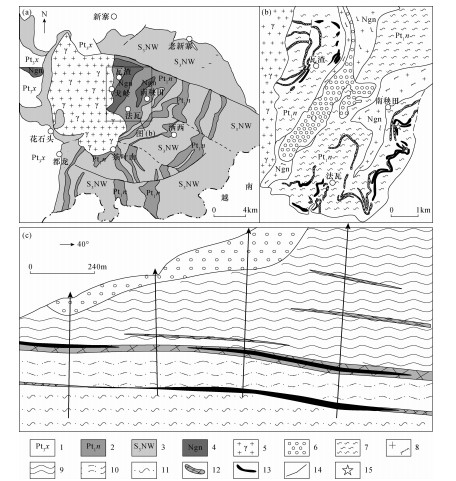
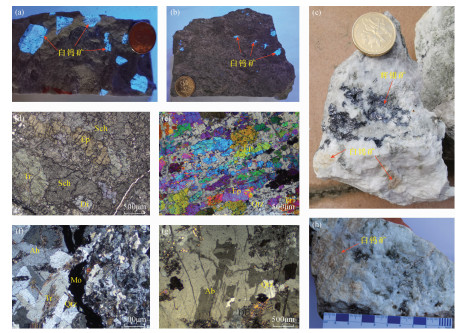
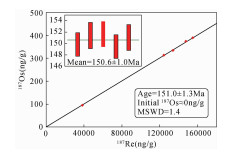
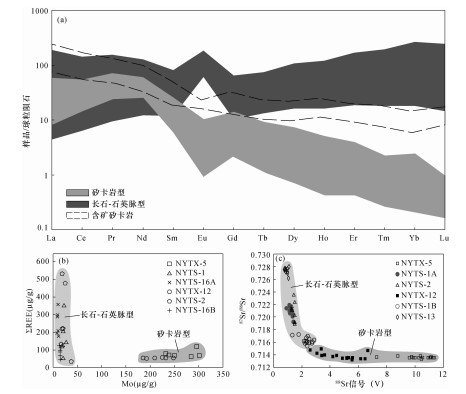
 京公网安备 11010202008159号
京公网安备 11010202008159号